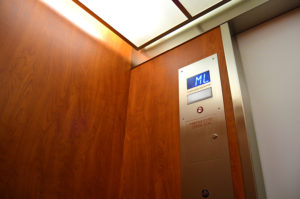Hydraulic Elevator Rumors
April 17, 2018Phoenix Modular Elevator Awards
April 20, 2018Tips – Dealing with an Elevator Modernization

The cost of a complete pit to roof-top machine room makeover can easily run in the tens of thousands or even hundreds of thousands of dollars, depending on the total travel distance, type of elevator, and work to be done. But writing the check is just the tip of the hatred iceberg.
Why the hate? Because modernization comes with a myriad of problems. As the building owner or manager, you have to make all sorts of decisions and accommodations, coordinating the intricate dance of building tenants with elevator personnel. Some need to get in and out and others up and down. Schedules have to be merged, communications opened, storage areas coordinated, parking and unloading allowed, inconveniences avoided, and ruffled feelings assuaged. Patience is the watchword, as modernization work can drag on from a couple months to often over a year. In that time span, patience can wear as thin as crepe paper. Then the anger and hate sinks in as reasonable people become less so.
It is best to snuff out the reason for the hate before you get hip deep, and proactive communication and understanding can keep you from that point of burning rage. Two lines of communication need to be opened, maintained, and nurtured, first to the tenant and then to the elevator company.
The Tenant
For the manager and building owners, it is important not to forget the tenant. These are the people that the elevator folks seem to forget to the point of being considered a near nuisance. The elevator techs feel that the tenants want in or out of the building in the middle of a crucial aspect of the elevator work, or that they interrupt the work with questions and complaints. However, it is important to remember that they, the tenants, are in essence paying for the modernization, as their rent is where the funds come from. But too often, their concerns are ignored or given the back seat. In both apartment buildings and office complexes, reliance on the elevator is the reality for the people who use and pay rent in the building.
Keep in mind that early on, for a day or so, hoofing it up a flight or two doesn’t seem all that inconvenient. But a week and a couple bunions later, you’ll see the best of tenants question the need for the new elevator equipment and wonder why it is taking so long. Be aware, of this and go the extra mile in communication and convenience. Part of that is being ready and willing to discuss the following in an open and forthright manner if you are the building manager or owner:
→ Why the update is needed. Is it safety? To bring the elevator up to code? Both? More? Be ready to explain everything, warts and all, pluses and negatives.
→ The timeline agreed to. Nothing is worse than mentally preparing yourself for a big inconvenience and then having it drag on for weeks past the promised deadline. Give updates often.
→ The noise. Let the tenants know that working on an elevator can be loud. There is sometimes drilling and hammering involved and heavy equipment being moved.
→ Dust, dirt, and grime. Let the tenants know that, although every effort will be made to contain the mess, some will sneak through. It is a work area.
→ Tenants’ needs. Ask how you can help your tenants out or if they have a significant need on the horizon. Sometimes it is nothing more than hiring some strong backs to do extra lifting or getting a hand truck.
→ Safety. Remind your tenants to follow directions and signs that warn of dangers.
The Elevator Contractor
There is a similar list for dealing with the elevator contractor. Often they will hedge, but a reputable and experienced elevator company will be able to give you the following information:
→ An honest timeline in writing. A day or two leeway is nice and forgivable, but beyond that and you should lower the boom. If the contractor is off the target more than a couple days, they either don’t know what they are doing, didn’t do a good job with the site survey, or didn’t follow the Modernization Checklist produced by NAEC. The bottom line is that if they are days or weeks off, it is not your fault but theirs. Let them know about it.
→ A list of your responsibilities. This should be contained in the contract you sign. Highlight them and make sure you are not the problem. If you promised the contractor after-hours access, then you must provide for that. If you promised them onsite storage, then you must give it to them. Don’t get in the way of the job finishing on time.
→ Special concerns or needs in writing. Memories are short, so don’t rely on yours. Also, no contract is carved in stone. Add anything that you want to make sure you are clear on compensation and to see to it that the concerns are addressed.
→ Comparative contracts. Let’s just say that you need to keep everyone honest. Sometimes they all come in close, but watch out if one is really low. They could be missing something big. Check what they are going to do in comparison to what the other companies are offering in writing–not just a nebulous “replace jack,” but each step and item required.
→ References. No, really, check references.
→ Non-propriety parts. Proprietary parts are nothing more than a gun to your head for a lucrative, one-way maintenance agreement with the installer. Don’t budge on this point; non-proprietary parts will cost you more in fees and maintenance over the life of the unit than the cost of the unit itself overall.
I know these lists of pointers cannot fully extinguish the angst of dealing with a modernization, but I certainly hope it helps. Whether we like it or not, every elevator will need updating at some point. So take your time, consider how you can help, and drop the hate. If you are in Southern Illinois and want a quote on a modernization go to our service page.
For more info here’s a link to our service page.
If a modernization is not in the cards but a new elevator is…click the button below. In less than a day you can have solid numbers.



